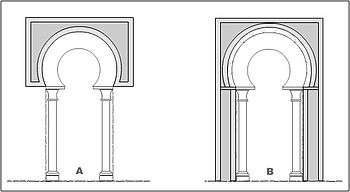Alfiz
The alfiz (Spanish: [alˈfiθ], Portuguese: [aɫˈfiʃ], perhaps from Andalusian Arabic alḥíz, from alḥáyyiz, from Classical Arabic ḥayyiz, meaning 'a container';[1] Catalan: arrabà [ərəˈβa]) is an architectonic adornment, consisting of a moulding, usually a rectangular panel, which encloses the outward side of an arch. It is an Islamic Arab architectonic ornament, but has appeared in non-Arab Spanish architecture since the 8th century.

It is frequent in the Islamic Hispanic art and mozarabic art (usually in connection with the horseshoe arch). As the image illustrates, there are two alfiz variants:
- A Alfiz starting from the impost.
- B Alfiz starting from the floor.
The space between the arch and the alfiz is called enjuta or arrabá, usually richly decorated (iron-gray in the illustration). Each curved triangle is called albanega (spandrel).
References
| Wikimedia Commons has media related to Alfiz. |